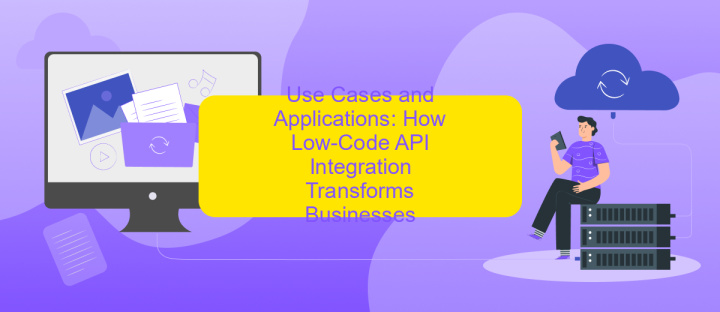Low-Code API Integration Platform
In today's fast-paced digital landscape, businesses are seeking efficient ways to streamline their operations and enhance connectivity. Low-code API integration platforms emerge as a game-changer, enabling organizations to effortlessly connect applications and automate workflows with minimal coding. These platforms empower users to build robust integrations quickly, reducing development time and costs while fostering innovation and agility in an increasingly interconnected world.
Introduction: Bridging the Gap with Low-Code API Integration
In today's rapidly evolving digital landscape, businesses are constantly seeking innovative ways to streamline operations and enhance productivity. Low-code API integration platforms have emerged as a pivotal solution, enabling organizations to bridge the gap between complex software systems and user-friendly interfaces. These platforms empower users to create seamless integrations without extensive coding knowledge, fostering agility and adaptability.
- Accelerated development processes by reducing the need for extensive coding.
- Enhanced collaboration between IT and business teams through intuitive interfaces.
- Cost-effective solutions by minimizing the reliance on specialized developers.
- Scalability and flexibility to meet evolving business needs.
- Improved time-to-market for new applications and services.
By leveraging low-code API integration platforms, organizations can unlock new levels of efficiency and innovation. These platforms not only simplify the integration process but also democratize it, allowing a broader range of users to participate in digital transformation initiatives. As a result, businesses can rapidly adapt to changing market demands, ensuring they remain competitive in an increasingly digital world. Embracing low-code solutions is no longer a luxury but a necessity for forward-thinking enterprises.
Understanding the Power of Low-Code API Platforms: Key Features and Benefits

Low-code API platforms are revolutionizing the way businesses integrate applications by simplifying the development process. These platforms provide a visual interface that allows users to design workflows and connect different systems with minimal coding. This approach not only accelerates the deployment of integrations but also reduces the dependency on specialized IT skills. Key features of low-code API platforms include drag-and-drop tools, pre-built connectors, and real-time data synchronization. These features empower organizations to quickly adapt to changing business needs and streamline operations.
The benefits of using low-code API platforms are significant. They enable faster time-to-market by reducing development cycles and increasing agility. Additionally, they lower costs associated with hiring and training technical staff. Platforms like ApiX-Drive exemplify these advantages by offering intuitive integration solutions that bridge various applications effortlessly. With ApiX-Drive, businesses can automate workflows, enhance productivity, and focus on core activities rather than technical complexities. Overall, low-code API platforms are crucial for modern businesses seeking efficient and scalable integration solutions.
Use Cases and Applications: How Low-Code API Integration Transforms Businesses

Low-code API integration platforms are revolutionizing the way businesses operate by simplifying the process of connecting different software systems. These platforms empower organizations to streamline workflows, enhance productivity, and reduce development time. By enabling non-technical users to create and manage integrations, businesses can quickly adapt to changing market demands and improve their overall efficiency.
- Automating Routine Tasks: Businesses can automate repetitive tasks, such as data entry and report generation, freeing up employees to focus on more strategic activities.
- Enhancing Customer Experience: By seamlessly integrating customer relationship management (CRM) systems with other platforms, companies can provide personalized and timely customer interactions.
- Improving Data Accuracy: Low-code platforms ensure consistent data flow between applications, reducing errors and enhancing decision-making processes.
- Accelerating Digital Transformation: Organizations can rapidly implement new technologies and integrate them with existing systems, fostering innovation and staying competitive.
In conclusion, low-code API integration platforms are transformative tools that enable businesses to optimize operations and drive growth. By reducing the complexity of system integrations, companies can focus on delivering value to their customers and achieving their strategic objectives. As the demand for agility and efficiency increases, the adoption of low-code solutions is expected to rise, further revolutionizing business processes across industries.
Choosing the Right Low-Code API Platform: Factors to Consider

When selecting a low-code API integration platform, it's crucial to evaluate several key factors to ensure it meets your organization's needs. The right platform can significantly enhance productivity and streamline workflows, but the wrong choice might lead to inefficiencies and increased costs.
Begin by assessing the platform's ease of use. A user-friendly interface can empower non-developers to create and manage integrations, reducing dependency on IT teams. Additionally, consider the platform's scalability. As your business grows, the platform should seamlessly accommodate increased data and user demands.
- Flexibility: Ensure the platform supports a wide range of APIs and can integrate with existing systems.
- Security: Verify that robust security measures are in place to protect sensitive data.
- Cost-effectiveness: Evaluate the pricing model to ensure it aligns with your budget and offers good value.
- Support and Community: Consider the availability of customer support and the presence of an active user community.
By carefully considering these factors, you can select a low-code API platform that not only meets current requirements but also adapts to future challenges. Making an informed decision will help your organization maximize the benefits of low-code technology.


Future Trends in Low-Code API Integration: What to Expect
The future of low-code API integration platforms is set to be transformative, driven by advancements in automation and AI. As businesses increasingly seek agility, these platforms will evolve to offer even more intuitive interfaces, enabling users with minimal technical expertise to design and deploy complex integrations swiftly. The integration of AI will further enhance these platforms, allowing for predictive analytics and automated decision-making processes that streamline operations. As a result, companies will be able to respond to market changes more proactively, maintaining a competitive edge.
Furthermore, platforms like ApiX-Drive are expected to expand their capabilities, offering a broader range of pre-built connectors and templates that simplify the integration process. This trend will cater to the growing demand for seamless connectivity between diverse applications and services. Security will also become a focal point, with enhanced encryption and compliance features ensuring data integrity and privacy. In this evolving landscape, low-code API integration platforms will play a crucial role in driving digital transformation, enabling businesses to innovate rapidly while reducing costs and resource dependency.
FAQ
What is a Low-Code API Integration Platform?
How does a Low-Code API Integration Platform work?
What are the benefits of using a Low-Code API Integration Platform?
Can Low-Code API Integration Platforms handle complex workflows?
How secure are Low-Code API Integration Platforms?
Apix-Drive will help optimize business processes, save you from a lot of routine tasks and unnecessary costs for automation, attracting additional specialists. Try setting up a free test connection with ApiX-Drive and see for yourself. Now you have to think about where to invest the freed time and money!

